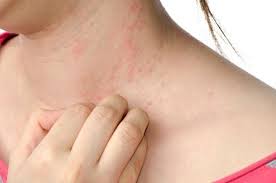Are your clothes giving you hives?

How many chemicals can you get in and/or on one shirt? pair of pants, pajamas or socks?
Well, there’s probably dye and wrinkle resistant resin that contains formaldehyde in the shirt and pants, as well as dye and maybe even fire retardant those jammies your tender-skinned baby has on. And according to a recent Australian study, there’s that irritating red dye in your work socks.
What to do? A study of 2069 patients from the general and occupational contact dermatitis clinics at the Skin and Cancer Foundation in Melbourne Australia revealed some interesting results. 7.6% of all the patients (157 people) reacted to textile related allergens. The most common reaction (30.6% of the people who reacted) was to formaldehyde and formaldehyde-releasing chemicals. The next most common reaction was to red dye (Basic red 46.) There were other reactions to blue dyes . Their conclusions were that “textile allergy is not uncommon.” ( http://www.ncbi.nim.nih.gov/pubmed/21309788. )
What does that mean for us?
If anything we are in even more danger from reactions to clothing because almost all the clothing we wear (unless it’s undyed, organic cotton) has anti-wrinkle agents, dyes, and in the case of children’s clothing, fire retardant.
Reactions can vary from hives to rashes to a “scalded” appearing redness on the skin. I have also had patients who have systemic reactions that include pain, swelling and fatigue. If you suspect you are reacting to an article of clothing, stop wearing it for a week, and then do a “challenge.”
If your symptoms go away during the week that it was sidelined, and come back when you put it on again, you can be pretty sure that it is the culprit. If you are still reacting, you may need to get tested for reactions to formaldehyde, dyes, p-phenylenediamine, and other tongue-twisting, skin irritating chemicals. Make sure you see an allergist that is familiar with testing for chemicals and dyes.
Obviously, we can’t all switch suddenly to wearing white caftans made of organic cotton. However, here are some things you can do:
- Use plain white cotton socks for sports and athletic activities
- Use lighter colored clothing against the skin, rather than clothing with heavy red, black or blue dyes
- If possible, get cotton or khaki pants (especially for children) that are not treated for wrinkle resistance and just take them out of the dryer right away, or have them pressed
- Be sure your children’s clothing does not contain fire retardant chemicals
- Avoid underwear with exposed latex elastic
- Avoid clothing that has tight bands, or rubs and irritates your skin
Dr Martha Howard








